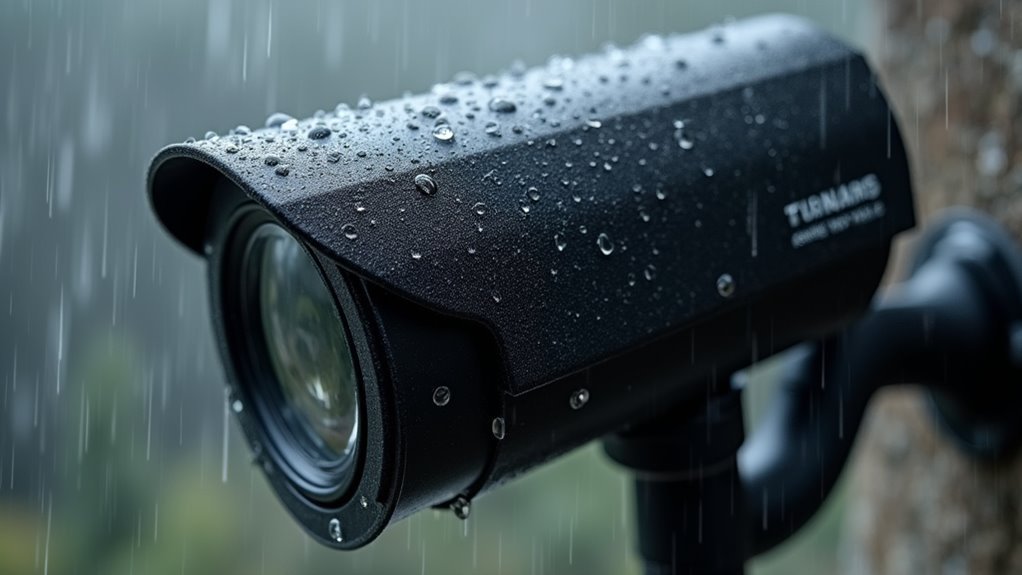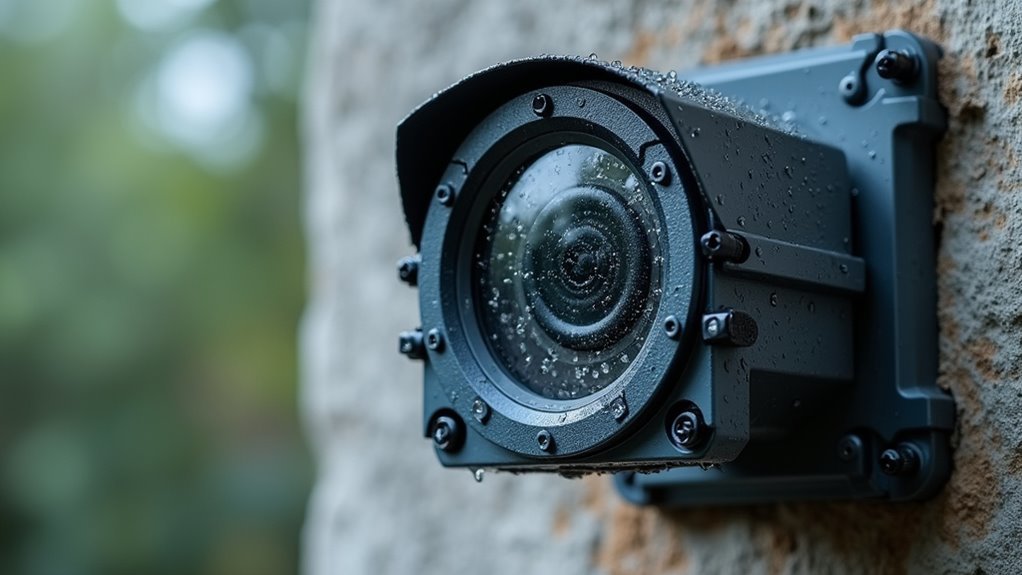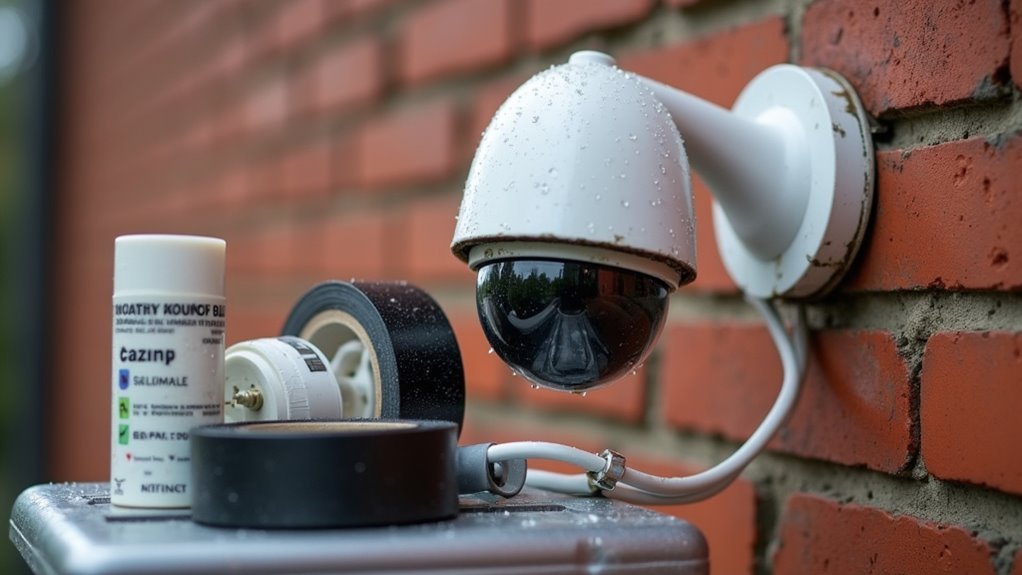You’ve probably wondered why some security cameras fail after their first rainstorm while others endure years of harsh weather without missing a beat. The difference isn’t just about price—it’s about understanding the specific engineering features that separate truly weather-resistant cameras from basic models. From IP ratings to specialized sealing techniques, there’s a science behind protecting these devices that most homeowners don’t realize exists.
Understanding IP Ratings and Protection Levels

The IP rating system serves as your primary guide when selecting weather-resistant security cameras, using a two-digit code that reveals exactly how well your equipment can handle dust and moisture.
The first digit (0-6) indicates dust protection levels, while the second digit (0-8) measures moisture resistance capabilities.
IP ratings use a simple two-digit system where the first number shows dust protection and the second indicates water resistance levels.
For outdoor cameras, you’ll want weatherproof protection starting at IP65, which provides dust-tight sealing and resistance to low-pressure water jets.
If you need maximum durability, IP67 ratings offer complete dust protection and can withstand temporary submersion up to one meter for thirty minutes.
Higher IP ratings directly correlate with increased durability – IP66 delivers superior water resistance compared to IP54’s limited splash protection.
Understanding these ratings guarantees you select cameras capable of withstanding your specific environmental conditions.
Essential Materials for Weather-Resistant Camera Construction
Five critical materials determine whether your security camera survives harsh environmental conditions or fails within months of installation. When you’re selecting durable materials for outdoor surveillance, aluminum housings offer superior protection against tampering and corrosion compared to standard plastic alternatives. Impact-resistant materials guarantee your camera withstands physical damage from debris or vandalism attempts.
| Material Component | Protection Type | Key Benefits |
|---|---|---|
| Aluminum Housing | Structural/Corrosion | Vandal resistance, longevity |
| Protective Seals | Moisture/Dust | Prevents water ingress |
| UV-Resistant Coatings | Sun Damage | Extends operational lifespan |
| Impact-Resistant Plastics | Physical Damage | Withstands harsh weather impacts |
You’ll need protective seals and gaskets to maintain weatherproof capabilities, while UV-resistant coatings prevent sun degradation that compromises camera functionality over time.
Protective Housing and Enclosure Design

Beyond selecting quality materials, your camera’s protective housing design determines how effectively these components work together to shield internal electronics from environmental threats.
Weather-resistant enclosures utilize sealed joints and gaskets that prevent dust and water penetration, directly impacting your camera’s IP rating. You’ll find ruggedized casings that provide impact resistance against wind, debris, and vandalism attempts.
Advanced enclosure design incorporates temperature control systems, including heating elements and cooling mechanisms, guaranteeing peak performance during extreme conditions.
Your camera’s housing also features visibility enhancements like anti-reflective coatings and sunshields that reduce glare while maintaining image clarity.
This all-encompassing protective housing approach guarantees your security system functions reliably despite challenging environmental factors, from torrential rain to scorching heat.
Sealing Techniques for Dust and Moisture Prevention
When environmental elements threaten your camera’s performance, effective sealing techniques form the critical barrier between reliable operation and costly equipment failure.
You’ll find that weather-resistant security cameras rely on rubber gaskets and O-rings to create airtight seals, preventing dust and moisture from penetrating the housing.
Conformal coating on electronic circuits enhances moisture prevention by protecting against humidity damage in wet conditions.
Specialized adhesives bond components tightly during assembly, strengthening your camera’s defense against harsh weather.
Advanced designs include pressure equalization vents that maintain air circulation without compromising protection.
High-quality materials like aluminum or polycarbonate casings provide structural support while enabling superior sealing performance for thorough dust and moisture prevention.
DIY Weatherproofing Methods for Existing Cameras

While manufacturers build weather-resistant cameras with sophisticated sealing systems, you can greatly enhance your existing camera’s protection through proven DIY weatherproofing methods. Start by installing weatherproof housing made from durable aluminum or high-quality plastic materials. Apply silicone sealant around gaps and openings to prevent moisture infiltration.
| Method | Material | Purpose | Frequency |
|---|---|---|---|
| Housing Installation | Aluminum/Plastic Enclosure | Complete Protection | One-time |
| Sealing Application | Silicone Sealant | Moisture Prevention | Annual |
| Protective Covering | Awning/Cover | Rain/UV Shield | One-time |
| Anti-corrosion Treatment | Protective Coating | Metal Protection | Bi-annual |
Add protective covers above cameras to shield against rain and UV rays. Apply anti-corrosion coatings on metal connections, especially in coastal areas. Regular maintenance involves cleaning lenses and removing debris buildup to guarantee peak performance.
Cable Management and Waterproof Connections
When you’re installing weather-resistant security cameras, you’ll need to focus on proper cable sealing and weatherproof connection methods to protect your system from moisture damage.
Your cables are vulnerable entry points where water can infiltrate and cause electrical failures, so sealing them correctly is just as important as choosing the right camera housing.
You can achieve reliable protection by using sealed connectors, heat-shrink tubing, and outdoor-rated cables designed to withstand UV exposure and temperature extremes.
Proper Cable Sealing
Every cable connection on your weather-resistant security camera system represents a potential failure point where moisture can infiltrate and compromise your equipment.
You’ll need proper cable sealing to prevent corrosion and equipment failure that results from moisture ingress. Use waterproof connectors and heat-shrink tubing to enhance connection durability in outdoor environments.
Seal all cable entry points with silicone or specialized weatherproofing materials to block dust and water penetration. Your cable management systems require regular inspection to identify wear and tear, ensuring connections stay secure during adverse weather.
Install cable clips or conduits to organize wiring while shielding connections from environmental factors. This extensive sealing approach protects your weather-resistant security cameras from harsh elements and extends their operational lifespan.
Weatherproof Connection Methods
Beyond basic cable sealing, implementing thorough weatherproof connection methods guarantees your security camera system maintains peak performance throughout its operational lifespan.
You’ll need waterproof connectors and enclosures that seal connections against rain and humidity, preventing moisture ingress that causes electrical failures.
Proper cable management includes using conduit or protective sheathing to shield cables from UV rays and extreme temperatures.
Apply weather-resistant sealants around cable entry points for enhanced protection against moisture compromise.
You should conduct regular inspections of all connections and protective measures to identify wear and tear before failures occur.
These extensive weatherproofing strategies create multiple protection layers, ensuring your surveillance system operates reliably despite harsh environmental conditions and extending your equipment’s service life considerably.
Temperature Resistance and Climate Considerations
Although outdoor security cameras face constant exposure to harsh environmental conditions, their temperature resistance capabilities determine whether they’ll continue protecting your property year-round.
Quality cameras operate effectively in extreme weather conditions, typically functioning within -40°F to 140°F ranges. Climate considerations become essential when selecting reliable surveillance equipment for your specific environment.
Key temperature resistance features include:
- IP67 rating protection against water submersion during flooding or heavy rainfall
- Cold weather functionality down to -22°F without component damage
- Heat protection systems preventing electronic degradation from direct sunlight exposure
- Built-in heating mechanisms for consistent performance in freezing temperatures
- Cooling systems that maintain ideal operating temperatures during summer heat
These temperature resistance features guarantee your outdoor security cameras maintain consistent performance regardless of seasonal variations or unexpected weather events.
UV Protection and Sun Damage Prevention
While temperature extremes pose significant threats to camera functionality, prolonged sun exposure creates equally damaging effects that can compromise your surveillance system’s effectiveness.
UV protection becomes essential for maintaining peak performance in outdoor cameras. Quality manufacturers incorporate UV-resistant materials and protective coatings that shield sensitive components from harmful radiation. These specialized housings prevent degradation, fading, and structural integrity loss that occurs under continuous sunlight exposure.
Quality manufacturers integrate UV-resistant materials and protective coatings to shield sensitive camera components from harmful solar radiation and prevent degradation.
Without proper sun damage prevention, you’ll experience lens discoloration and image distortion that renders your surveillance unreliable.
Anti-UV additives in camera materials promote long-term durability, while regular lens maintenance helps mitigate accumulated damage. When selecting outdoor cameras, prioritize models specifically designed with thorough UV protection features to guarantee clear visibility and extended operational lifespan in harsh sunlight conditions.
Wind and Impact Resistance Features
When violent storms and deliberate vandalism threaten your surveillance equipment, robust construction becomes your first line of defense against costly damage and security gaps.
Weatherproof security cameras designed for harsh environmental conditions incorporate specialized protective features that guarantee your surveillance system maintains operation when you need it most.
Key wind and impact resistance features include:
- High-quality plastic or metal housings that resist corrosion and physical impacts
- Wind resistance ratings exceeding 50 mph for sustained operation during storms
- Impact resistance standards like IK10 ratings, withstanding 5kg objects dropped from 40cm
- Reinforced designs that prevent damage from vandalism attempts
- Weatherproof gaskets protecting against wind-driven rain and debris
These protective features work together, creating cameras that won’t fail during critical moments.
Corrosion Prevention for Metal Components
You’ll need robust metal coating technologies to shield your security camera’s components from rust and corrosion damage.
These specialized coatings work alongside extensive environmental protection methods to create multiple barriers against moisture, salt, and other corrosive elements.
Your camera’s longevity depends on how effectively these protective systems prevent metal degradation in harsh outdoor conditions.
Metal Coating Technologies
Since outdoor security cameras face constant exposure to moisture, salt air, and temperature fluctuations, metal coating technologies serve as the first line of defense against corrosion that can compromise your system’s reliability.
These advanced coating methods create robust barriers that shield critical components from environmental elements:
- Galvanization applies protective zinc layers to steel surfaces, dramatically improving corrosion resistance.
- Powder coating delivers weather-resistant finish through heat-cured dry powder application.
- Anodizing strengthens aluminum’s natural oxide layer via electrochemical processes.
- Corrosion-resistant alloys like stainless steel provide inherent durability against rust.
- Regular maintenance guarantees coating integrity and prevents accelerated degradation.
When you invest in cameras with quality metal coating technologies, you’re securing long-term performance that withstands harsh outdoor conditions while minimizing replacement costs.
Environmental Protection Methods
While quality coatings provide essential surface protection, extensive environmental protection methods create multi-layered defense systems that safeguard your camera’s metal components from corrosion throughout their operational lifespan.
You’ll find weatherproof cameras utilize corrosion-resistant metals like stainless steel and aluminum as foundational materials. Sealing gaskets and O-rings create critical barriers preventing moisture ingress into internal assemblies.
These protective coatings work alongside high-quality plastics and composites for non-metal components, reducing overall corrosion risk while maintaining structural integrity in challenging outdoor environments.
Regular maintenance becomes your final defense layer—you should inspect and clean metal components to prevent salt and debris buildup that accelerates deterioration.
This thorough approach guarantees your security system withstands harsh environmental conditions effectively.
Drainage Systems and Condensation Control
When water accumulates inside your security camera housing, it can destroy sensitive electronics and create foggy footage that renders your surveillance system useless.
That’s why effective drainage systems are vital for protecting your investment.
Quality weather-resistant cameras feature multiple layers of moisture protection:
- Built-in drainage channels direct rainwater away from sensitive electronics and lens assemblies
- Vented enclosures allow air circulation while preventing water ingress through strategic placement
- Desiccant materials absorb excess humidity inside the housing to prevent condensation buildup
- Proper sealing with gaskets creates watertight barriers around critical access points
- Strategic runoff design prevents water pooling around vulnerable areas
Condensation control is equally important.
Without it, temperature changes create internal moisture that fogs your lens and corrodes internal components.
Regular maintenance guarantees these systems continue protecting your surveillance equipment effectively.
Gaskets and O-Ring Installation Techniques
Although drainage channels and vents form your camera’s first line of defense against moisture, gaskets and O-rings create the critical seals that make these systems truly weatherproof.
Your installation techniques directly impact sealing effectiveness, so you’ll need to start with clean, debris-free mating surfaces before positioning these components.
Choose materials like silicone or neoprene that resist temperature fluctuations and UV degradation.
During installation, you’ll want to achieve proper O-ring compression—over-compression causes deformation while under-compression creates leaks. Both scenarios compromise your camera’s weather resistance.
Don’t forget about ongoing maintenance.
Regular inspection of gaskets and O-rings prevents wear and tear, ensuring your security camera maintains its weatherproof capabilities throughout its operational life.
Testing Your Weatherproofing Effectiveness
After installing your gaskets and O-rings, you’ll need to verify that your weatherproofing measures actually work under real-world conditions.
Testing confirms your weatherproof cameras can resist moisture and function reliably during adverse weather events that threaten your security system’s performance.
Here’s how to test your weatherproofing effectiveness:
- Check the IP rating – verify your cameras meet minimum IP65 standards for outdoor use
- Conduct physical inspections after storms to identify water ingress or housing damage
- Test video capture quality during rain or snow to verify clarity isn’t compromised
- Use a multimeter to confirm electrical connection integrity and power supply stability
- Schedule routine maintenance to clean lenses and inspect seals for continued protection
Regular testing validates your weatherproofing investment and prevents costly failures.
Maintenance Tips for Long-Term Weather Protection
While testing confirms your initial weatherproofing efforts, maintaining that protection requires ongoing attention to keep your security cameras performing reliably year after year.
Regular maintenance starts with cleaning camera lenses to prevent dirt, water spots, or snow buildup that compromises image quality. You’ll need to inspect housing for wear or damage, especially after severe weather events, ensuring continued durability.
Test night vision capabilities periodically to confirm infrared lights function properly in low-light conditions. Keep software updated to enhance security features and improve overall performance while maintaining compatibility with latest technologies.
Establish routine inspections and address emerging issues promptly. This proactive approach extends your weatherproof camera system’s lifespan and reliability considerably.
Frequently Asked Questions
How Do You Weatherproof a Security Camera?
You’ll weatherproof your security camera by choosing one with IP65 or IP67 rating, installing it under protective cover, using weather-resistant housing materials, and performing regular maintenance to check seals.
What Is the Difference Between Weatherproof and Waterproof Cameras?
You’ll find weatherproof cameras resist light rain and dust with IP54+ ratings, while waterproof cameras handle submersion and extreme conditions with IP67+ ratings, offering stronger seals and specialized housing for superior protection.
What Does Weatherproof Mean on a Camera?
Weatherproof on a camera means you’re getting protection from rain, snow, dust, and temperature extremes through specialized enclosures and seals that’ll keep your device functioning reliably outdoors year-round.
Is It Illegal for My Neighbor to Have a Camera Pointed at My House?
It’s generally legal for your neighbor’s camera to point toward your house if it captures public areas. However, it’s illegal if the camera records private spaces where you’d expect privacy, like inside your home.





Leave a Reply